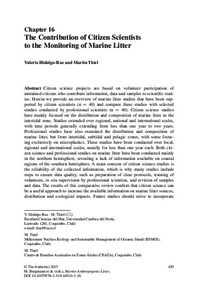| dc.contributor.author | Hidalgo-Ruz, Valeria | |
| dc.contributor.author | Thiel, Martin | |
| dc.date.accessioned | 2019-12-15T21:54:42Z | |
| dc.date.available | 2019-12-15T21:54:42Z | |
| dc.date.issued | 2015 | |
| dc.identifier.citation | Hidalgo-Ruz, V. and Thiel, M. (2015) The Contribution of Citizen Scientists to the Monitoring of Marine Litter. In: Marine Anthropogenic Litter, (eds Bergmann, M., Gutow, L. and Klages, M.). Heidelberg, Springer Open, pp.429-447. DOI: https://doi.org/10.1007/978-3-319-16510-3_16 | en_US |
| dc.identifier.uri | http://hdl.handle.net/11329/1179 | |
| dc.identifier.uri | http://dx.doi.org/10.25607/OBP-697 | |
| dc.description.abstract | Citizen science projects are based on volunteer participation of
untrained citizens who contribute information, data and samples to scientific studies.
Herein we provide an overview of marine litter studies that have been supported
by citizen scientists (n = 40) and compare these studies with selected
studies conducted by professional scientists (n = 40). Citizen science studies
have mainly focused on the distribution and composition of marine litter in the
intertidal zone. Studies extended over regional, national and international scales,
with time periods generally extending from less than one year to two years.
Professional studies have also examined the distribution and composition of
marine litter, but from intertidal, subtidal and pelagic zones, with some focusing
exclusively on microplastics. These studies have been conducted over local,
regional and international scales, usually for less than one year each. Both citizen
science and professional studies on marine litter have been conducted mainly
in the northern hemisphere, revealing a lack of information available on coastal
regions of the southern hemisphere. A main concern of citizen science studies is
the reliability of the collected information, which is why many studies include
steps to ensure data quality, such as preparation of clear protocols, training of
volunteers, in situ supervision by professional scientists, and revision of samples
and data. The results of this comparative review confirm that citizen science can
be a useful approach to increase the available information on marine litter sources,
distribution and ecological impacts. Future studies should strive to incorporate additional citizen scientists who frequent marine environments, for instance, divers
and sailors, to improve our understanding of marine litter dynamics. | en_US |
| dc.language.iso | en | en_US |
| dc.publisher | Springer Open | en_US |
| dc.rights | Attribution-NonCommercial 4.0 International | * |
| dc.rights.uri | http://creativecommons.org/licenses/by-nc/4.0/ | * |
| dc.subject.other | Marine litter | en_US |
| dc.subject.other | Microplastics | en_US |
| dc.subject.other | Marine plastics | en_US |
| dc.subject.other | Data quality | en_US |
| dc.subject.other | Citizen Science | en_US |
| dc.title | The Contribution of Citizen Scientists to the Monitoring of Marine Litter. | en_US |
| dc.type | Book Section | en_US |
| dc.description.status | Published | en_US |
| dc.description.refereed | Refereed | en_US |
| dc.publisher.place | Heidelberg, Germany | |
| dc.format.pagerange | pp.429-47 | en_US |
| dc.identifier.doi | https://doi.org/10.1007/978-3-319-16510-3_16 | |
| dc.subject.parameterDiscipline | Parameter Discipline::Environment::Anthropogenic contamination | en_US |
| dc.description.currentstatus | Current | en_US |
| dc.contributor.editorparent | Bergmann, Melanie | |
| dc.contributor.editorparent | Gutow, Lars | |
| dc.contributor.editorparent | Klages, Michael | |
| dc.title.parent | Marine Anthropogenic Litter. | en_US |
| dc.description.sdg | 14.1 | en_US |
| dc.description.bptype | Manual (incl. handbook, guide, cookbook etc) | en_US |
| obps.contact.contactemail | thiel@ucn.cl | |
 Repository of community practices in Ocean Research, Applications and Data/Information Management
Repository of community practices in Ocean Research, Applications and Data/Information Management

